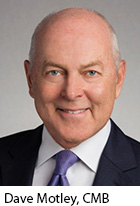
‘Be Prepared For a Change’
SAN DIEGO–Make hay while the sun shines, but be prepared for a storm when clouds appear, said Mortgage Bankers Association Chairman Dave Motley, CMB.
 “Commercial and multifamily businesses have enjoyed a robust market for the past several years,” Motley said here at the MBA Commercial Real Estate Finance/Multifamily Housing Convention & Expo. “This $3 trillion business has been booming for quite some time. And with a growing economy and growing jobs, the future outlook is promising for commercial/multifamily businesses.”
“Commercial and multifamily businesses have enjoyed a robust market for the past several years,” Motley said here at the MBA Commercial Real Estate Finance/Multifamily Housing Convention & Expo. “This $3 trillion business has been booming for quite some time. And with a growing economy and growing jobs, the future outlook is promising for commercial/multifamily businesses.”
But Motley, President of Colonial Savings F.A., Fort Worth, Texas, warned conference attendees to prepare for the change that will inevitably occur. “It’s the business cycle; it’s just the way things work,” he said. “At some point–hopefully not too soon–this bullish market will inevitably take a turn.”
Motley said commercial and multifamily real estate professionals need to make the most of what remains of this cycle to prepare for the next turn. “My goal as your chairman–and MBA’s goal–is to make sure you continue doing business and growing your business, no matter the economic or political atmosphere,” he said.
Motley noted a healthy tension within many aspects of the business. “With multifamily, we have a tug-of-war between supply and demand,” he said. “On one side we have millennials and baby boomers, both groups renting like never before. On the other side we have developers doing what they do so well and more multifamily units under construction than at any time since the mid-1970s.”
In some markets, apartment supply has outpaced demand, while in others rental costs still outpace wage growth, Motley said. “More than with any other property type, that push-and-pull between supply and demand is the driving theme of today’s multifamily market,” he said.
This tug-of war carries on in the office market, Motley said, noting the U.S. has experienced steady employment growth for the last seven years, but on the other side of the coin employers have become much more efficient in how they use their space. “MBA is the perfect example,” he said. “When CEO Dave Stevens looked to move the organization to new space, he looked for a more efficient space with less offices. At the same time, MBA has grown in staff. To accommodate this growth, MBA has instituted an office-sharing and telecommuting program. So, the number of employees has grown, but MBA is not looking for new space.”
Though retail store closures grab many headlines, the news may be a bit overblown in this area, Motley said. “Not every mall or shop in America is dying; people are still shopping, just not in the same ways,” he said.
E-commerce has indeed grown dramatically–often at the expense of brick-and-mortar stores–but online sales still represent just 8.9 percent of all retail sales, Motley said. “We cannot deny the tension of how much space is actually needed given previous building booms and the competition of online shopping,” he added. “What is the right balance in retail? That’s what we’re working through. Right now. In real time.”
At the same time, e-commerce growth has boosted the industrial sector, Motley said. He said developers expect to build 225 million new square feet of warehouse space this year, nearly the same as last year’s total and more than double the 10-year average of 120 million square feet.
“This tension happens across markets and property types,” Motley said. “The current moment in the market a good time to sharpen both pencils and perspectives and be prepared for anything.”
